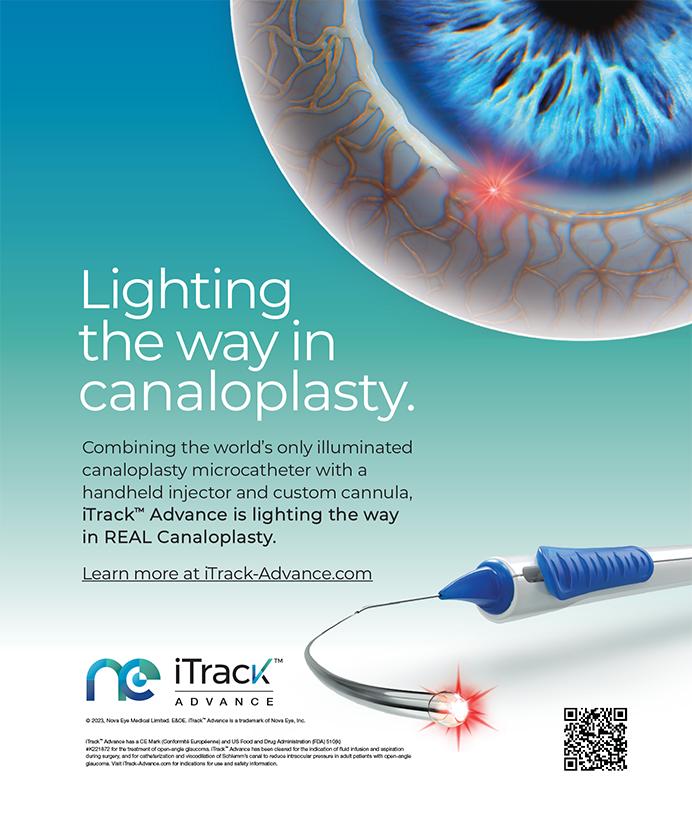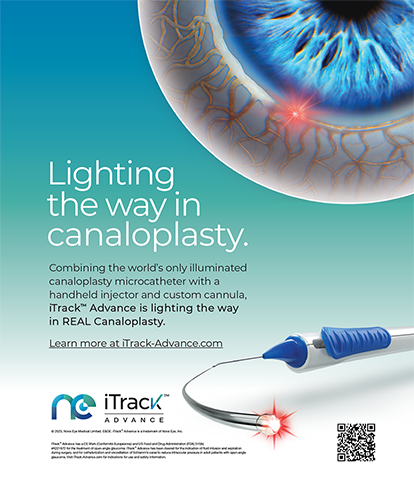During the past 15 years, several studies have found a modest but sustained reduction in IOP after cataract surgery. A study from my institution is typical. In a retrospective review of 266 consecutive patients without glaucoma who had uncomplicated clear corneal cataract surgery, my colleagues and I recorded a mean IOP reduction of 7.8% (P < .001) 2 years after surgery.1 Similar reductions in IOP after cataract surgery have been reported in patients classified as glaucoma suspects and in those with open-angle glaucoma (OAG).2 A recent review nicely summarizes the literature on the subject.3 Such research certainly raises the question of whether cataract surgery alone can be considered an effective treatment option for patients with glaucoma.
PRIMARY OPEN-ANGLE GLAUCOMA
At the time of this writing, there are no randomized controlled trials (RCTs) analyzing the effect of cataract extraction alone on IOP in patients with primary OAG. A 2002 meta-analysis of 39 studies and several thousand glaucoma patients found strong evidence that sustained IOP lowering was greater in patients who underwent cataract surgery combined with trabeculectomy than in patients receiving just cataract surgery.4 The study found only weak evidence supporting a minimal (2-4 mm Hg) but consistent decrease in IOP with cataract surgery alone.4 Research published since has confirmed a similarly small reduction in IOP after cataract surgery in patients with OAG.2,5 The decrease in IOP after cataract surgery may be slightly greater in patients with exfoliation syndrome. 6 Is this rather small IOP reduction after cataract surgery sufficient to be considered an effective therapeutic intervention in OAG patients? Based on their review of the evidence from these studies and others, two groups of investigators recently offered their conclusions on the subject. The first stated, “in eyes with open-angle glaucoma, cataract surgery alone may be of limited clinical benefit in lowering IOP.”7 The second group, as stated in their article’s title, found “insufficient evidence to recommend lens extraction [alone] as a treatment for primary openangle glaucoma.”8
Alternatively, two recent reports presented provocative data suggesting that the decrease in IOP after cataract surgery is proportional to the preoperative IOP in patients with ocular hypertension and glaucoma (ie, the higher the preoperative IOP, the greater the IOP reduction after cataract surgery).9,10 The reports’ authors suggest that cataract surgery alone be considered an effective therapeutic intervention for patients with ocular hypertension and glaucoma (presumably openangle). 10 In interpreting the data from these two studies as well as from most other retrospective research on the subject, including that in which I participated, it is important to note two things. First, gonioscopy is not recorded, which is essential in this context to rule out occult angle-closure disease, as will become apparent later in this article.8 Second, because multiple preoperative IOP measurements are not obviously recorded, the statistical phenomenon of regression to the mean cannot be discounted.3
Without solid RCT data to definitively place cataract surgery in the glaucoma treatment algorithm, the best available evidence would therefore suggest that the ideal OAG patient for stand-alone cataract surgery has mildto- moderate glaucoma that is well controlled on a tolerable medical regimen and a visually significant cataract. In such a patient, cataract surgery alone is probably safe from an IOP standpoint and may modestly reduce the pressure. For patients with uncontrolled and progressive glaucoma, however, who need a protective reduction in IOP as well as removal of a visually significant cataract, cataract surgery combined with an IOP-lowering procedure, usually trabeculectomy, would still be considered the standard. The data from the studies cited earlier2,5,9,10 suggesting a treatment benefit in OAG patients from cataract surgery alone, however, are compelling enough to warrant further research. An RCT assessing this treatment modality in primary OAG patients would be most welcome.
PRIMARY ANGLE-CLOSURE GLAUCOMA
Unlike with OAG, published data from RCTs support cataract surgery alone as a viable, indeed important, treatment modality in patients with primary acute and chronic angle-closure glaucoma (APAC and CACG, respectively). Lam et al randomized 62 Chinese subjects with cataract to receive either early phacoemulsification or laser iridotomy after medically aborted APAC. Those undergoing phacoemulsification had a lesser increase in IOP during the 18 months following treatment than those receiving an iridotomy.11
Tham et al randomized patients with medically controlled and uncontrolled CACG and cataract to undergo either phacoemulsification alone or phacoemulsification combined with trabeculectomy and adjunctive mitomycin C.12,13 The researchers found combined surgery to be marginally more effective in lowering IOP in the medically controlled CACG group and significantly more effective in the medically uncontrolled group. Phacoemulsification alone resulted in a significant long-term IOP reduction compared to preoperative levels, however, for both the medially controlled and uncontrolled CACG groups. In addition, the complication rate was higher in the combined-surgery group in both studies, leading the authors to conclude that, “On the basis of the data from these two studies, phacoemulsification alone is a viable surgical alternative to combined phacotrabeculectomy in CACG eyes with coexisting cataract, whether the preoperative IOP is medically controlled or not.”13
In addition, the three review articles cited earlier that found little data to support cataract surgery alone as an effective treatment for OAG all acknowledged sufficient published evidence to establish cataract surgery by itself as a viable treatment modality in the management of primary angle-closure disease.3,7,8
CONCLUSION
Cataract surgery alone has not yet been firmly established with strong RCT data as a reliable, reproducible treatment modality for patients with OAG. In contrast, solid available RCT data support cataract surgery as an important treatment option in patients with both APAC and CACG. It is important to note, however, that the available RCT data establish only the removal of a visually significant cataract as a viable treatment modality in angle-closure disease. Similar RCT data establishing the effectiveness of clear lens extraction for the treatment of angle-closure disease is not yet available, although this idea is theoretically plausible.14,15
Norman Zabriskie, MD, is an associate clinical professor in the John A. Moran Eye Center, Department of Ophthalmology, University of Utah School of Medicine, Salt Lake City. Dr. Zabriskie may be reached at (801) 585- 3071; norm.zabriskie@hsc.utah.edu.
- Irak-Dersu I,Nilson C,Zabriskie N,et al.Intraocular pressure change after temporal clear corneal phacoemulsification in normal eyes.Acta Ophthalmol.2010;88:131-134.
- Shingleton BJ,Pasternack JJ,Hung JW,O’Donoghue MW.Three and five year changes in intraocular pressures after clear corneal phacoemulsification in open angle glaucoma patients,glaucoma suspects,and normal patients.J Glaucoma.2006;15:494-498.
- Shrivastava A,Singh K.The effect of cataract extraction on intraocular pressure.Curr Opin Ophthalmol. 2010;21:118-122.
- Friedman DS,Jampel HD,Lubomski LH,et al.Surgical strategies for coexisting glaucoma and cataract. Ophthalmology.2002;109:1902-1915.
- Mathelone N,Hyams M,Neiman S,et al.Long-term intraocular pressure control after clear corneal phacoemulsification in glaucoma patients.J Cataract Refract Surg.2005;31:479-483.
- Shingleton BJ,Heltzer J,O’Donoghue MW.Outcomes of phacoemulsification in patients with and without pseudoexfoliation syndrome.J Cataract Refract Surg.2003;29:1080-1086.
- Vizzeri G,Weinreb RN.Cataract surgery and glaucoma.Curr Opin Ophthalmol.2010;21:20-24.
- Walland MJ,Parikh RS,Thomas R.There is insufficient evidence to recommend lens extraction as a treatment for primary open angle glaucoma:an evidence-based perspective (published online ahead of print June 13,2011).Clin Experiment Ophthalmol.doi:10.1111/j.1442-9071.2011.02617.x.
- Poley BJ,Lindstrom RL,Samuelson TW.Long-term effects of phacoemulsification with intraocular lens implantation in normotensive and ocular hypertensive eyes.J Cataract Refract Surg.2008;34:735-742.
- Poley BJ, Lindstrom RL, Samuelson TW, Schulze R.Intraocular pressure reduction after phacoemulsification with intraocular lens implantation in glaucomatous and nonglaucomatous eyes.J Cataract Refract Surg. 2009;35:1946-1955.
- Lam DSC,Leung DYL,Tham CCY,et al.Randomized trial of early phacoemulsification versus peripheral iridotomy to prevent intraocular pressure rise after acute primary angle closure.Ophthalmology.2008;115:1134-1140.
- Tham CCY,Kwong YYY,Leung DYL,et al.Phacoemulsification versus combined phacotrabeculectomy in medically controlled chronic angle closure glaucoma with cataract.Ophthalmology.2008;115:2167-2173.
- Tham CCY,Kwong YYY,Leung DYL,et al.Phacoemulsification versus combined phacotrabeculectomy in medically uncontrolled chronic angle closure glaucoma with cataracts.Ophthalmology.2009;116:725-731.
- Thomas R,Walland MJ,Parikh RS.Clear lens extraction in angle closure glaucoma.Curr Opin Ophthalmol. 2011;22:110-114.
- Tarongoy P,Ho CL,Walton DS.Angle-closure glaucoma:the role of the lens in the pathogenesis,prevention,and treatment.Surv Ophthalmol.2009;54:211-225.


